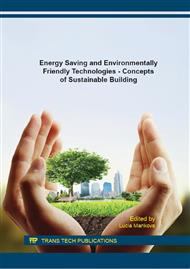[1]
P. ORAVEC. Windows in buildings - diagnostics of selected properties after time of using. In International Conference on Buildings and Environment, EnviBUILD 2013, Bratislava, Slovakia, 17. 10. 2013. Advanced Materials Research, Vol. 899, 2014, pp.184-187.
DOI: 10.4028/www.scientific.net/amr.899.184
Google Scholar
[2]
L. ŠTEFFEK, P. JELÍNEK, J. KALÁNEK and M. OSTRÝ. The Impact of the choice of computational methods on the results of simulations of specific heat consumption for heating a family house. In International Conference on Buildings and Environment, EnviBUILD 2013, Bratislava, Slovakia, 17. 10. 2013. Advanced Materials Research, Vol. 899, 2014, pp.161-165.
DOI: 10.4028/www.scientific.net/amr.899.161
Google Scholar
[3]
R. INGELI, B. VAVROVIČ and M. ČEKON. Thermal bridges minimizing through typical details in low energy designing. In International Conference on Buildings and Environment, EnviBUILD 2013, Bratislava, Slovakia, 17. 10. 2013. Advanced Materials Research, Vol. 899, 2014, pp.62-65.
DOI: 10.4028/www.scientific.net/amr.899.62
Google Scholar
[4]
J. LABUDEK and P. ORAVEC. Energy solar wall in low-energy apartment house. In International Conference on Buildings and Environment, EnviBUILD 2012, Brno, Czech Republic, 25. - 26. 10. 2012. Advanced Materials Research, Vol. 649, 2013, pp.155-158.
DOI: 10.4028/www.scientific.net/amr.649.155
Google Scholar
[5]
73 0540 - 2. Thermal protection of buildings: Part 2 Requirements. Prague: Czech Standards Institute, (2011).
Google Scholar
[6]
K. KUBENKOVÁ and M. JAŠEK. The issue of including the influence of thermal bonds in the passive house. In International Conference on Buildings and Environment, EnviBUILD 2014, Brno, Czech Republic, 18. - 19. 9. 2014. Advanced Materials Research, Vol. 1041, 2014, pp.121-124.
DOI: 10.4028/www.scientific.net/amr.1041.121
Google Scholar
[7]
V. Kočí and collective. LCA and EPD of construction products. Praha, Czech Republic, 2012. ISBN: 978-80-260-3504-6.
Google Scholar
[8]
Catalog materials [online]. [cit. 2015-04-29]. Information on: http: /www. envimat. cz/materialy.
Google Scholar
[9]
Baubook klima: aktiv häuser kriterien und produkte [online]. [cit. 2015-06-29]. Information on: https: /www. baubook. at/kahkp.
Google Scholar
[10]
M. Vonka and collective. Methodology SBTollCZ - manual evaluation of residential buildings in the design phase. Praha, Czech Republic, 2011. ISBN: 978-80-01-04664-7.
Google Scholar


